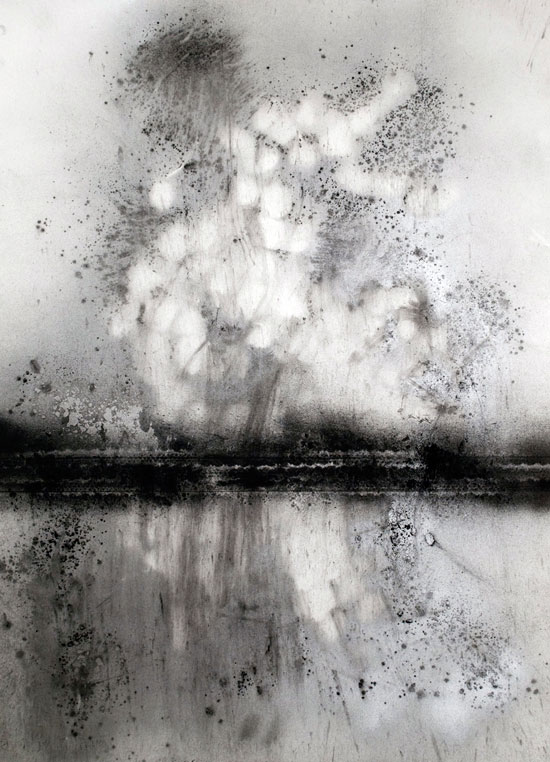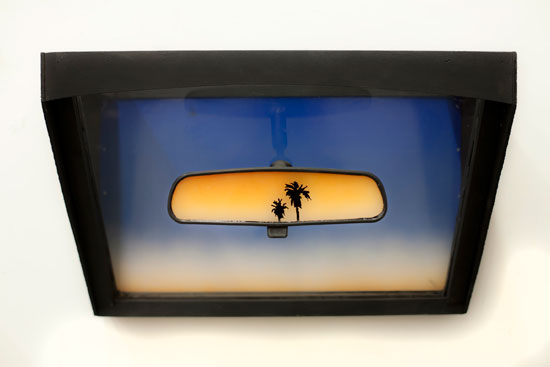Frequent visitors to Kathryn Markel Fine Arts in Bridgehampton may be surprised at the season exhibition opener on view. The gallery is known for presenting paintings and sculpture that manifest beauty and is made by artists with in-depth art knowledge and mastery of technique. Aesthetics aside, the exhibition “Everything Has Its Place” is consistent with the gallery’s focus. What sets this show apart is a strong current of conceptualism pulsating in the mostly edgy contemporary art on view. But know this: easy-to-look-upon aesthetics may or may not be a motivator for the art on view.
“Everything Has Its Place” features emerging artists selected by curator and artist Robert Dimin of New York City. A conceptual artist himself, it’s not a surprise Dimin’s choices for his inaugural curatorial appearance in the Hamptons harnesses his preferance for idea-driven artwork.
While selecting artworks for the show, Dimin said he tried to select art that may appeal to a Hamptons art viewing audience while introducing a strong list of emerging artists that may not be known on Eastern Long Island. As a result, “Everything Has Its Place” is a compelling mix of beauty, brains and intrigue.
Exhibiting in the show are Nick Doyle, Justine Hill, Bradley LaMere, Corey Riddell, Dana Sherwood and Bryan McGovern Wilson. Artworks include painting, photography, sculpture and installation.
Works that possess aesthetic beauty can be most easily found in exhibited art by Hill, Riddell and LaMere.
Hill presents abstract paintings that channel abstract painting history yet are fully contemporary and rendered to be read in their entirety (rather than the exploration of marks, color choices and the artist’s self). She uses layering, gesture, lines and blocks of color to explore landscapes as living spaces that can possess multiple simultaneous worlds, relationships and a possible yearning for equilibrium that real world limitations may thwart.
.
.
Riddell also combines history with contemporary times in color gravures that capture sublime natural scenes shrouded in shadow. Riddell creates his images by using techniques from photography’s early days of chemical and mechanical-dependent processes.
.
.
LaMere’s charcoal and graphite drawings are abstract yet seem to have a strong implication of place, memory or narrative. Gesture and texture are important to LaMere when making his art, according to his Artist Statement. So are imbibing his drawings with sensations conjured by the psychological and historical implications of the locations that tickle LaMere’s muse and encouraged imagined narratives to bloom and grow and find their way into his art.
.

"Untitled #6 - Swing Low Series" by Brad LaMere, 2013. Powdered charcoal and graphite on paper, 22 x 30 inches.
.
Doyle’s wall sculpture channels the concept of beauty and memory in his piece “Rearview.” Packed with California cool, the work presents an aesthetic appreciation of a palm tree landscape near sunset coupled with the sensation of simultaneously reflecting on the day just spent while looking forward to what lies ahead.
.

"Rearview" by Nick Doyle, 2013. Lexan, plywood, spray paint, rearview mirror, 20.5 x 13.5 x 11.5 inches.
.
The most challenging works in “Everything Has Its Place” are by Wilson and Sherwood. Both artists have project-specific photography presented in the main exhibition space and space-specific installations in outlying areas of Kathryn Markel Fine Arts.
Wilson’s art is concerned with time, body and ritual. To create his multidisciplinary artwork, he draws inspiration from archaic symbolism, traditions from craft and extensive field research. In “Everything Has Its Place,” Wilson presents the detailed yet imaginary world of The Atomic Priesthood.
.

Installation (partial) of "The Atomic Priesthood" by Bryan McGovern Wilson at Kathryn Markel Fine Arts in Bridgehampton, NY.
.
Extensive and obsessive in scope, The Atomic Priesthood presents artifacts, history and bi-products of investigative research by members of a secret (and imaginary) society of individuals charged with public information management to keep areas destroyed through contamination by nuclear weapon and nuclear energy bi-products.
.

Installation (partial) of "The Atomic Priesthood" by Bryan McGovern. Wilson at Kathryn Markel Fine Arts in Bridgehampton, NY.
.
Wilson’s art project of an imagined secret society is based on a real commissioned report from the 1980s written by semiotician Thomas A. Sebeok for the U.S. Office of Nuclear Waste Management. The report “Communication Measures to Bridge Ten Millennia” presented, by way of a solution to keep future generations from reinhabitating areas contaminated by nuclear fallout, the founding of a secret “atomic priesthood” of scientific experts.
Members would serve as technical information keepers and propagators of scientific data related to condemned areas. They would also be charged with preventing future citizens from resettling contaminated areas through well-intentioned “folklore allegory” campaigns.
For the Bridgehampton exhibition, Wilson created a full-room installation revealing the inner workings and implements of the atomic priesthood, as if it truly existed.
The installation has a natural history museum exhibition feel with artifacts presented in logical groups on shelves, lifestyle items (boots, a jacket, personal items), secret society documents, photographs and research data. Taken together, the installation is meant to reveal the inner workings of the rituals and undertakings of this secret society.
In the gallery’s main exhibition area, Wilson presents several photographs of a figure in a landscape. The images are beautiful and arresting. Each photograph is meant to represent Sebeok in action, said Dimin. In fact, the Polaroid Transfer captures Wilson playing the part of Sebeok in an imaginary scene from The Atomic Priesthood.
.

"Trinity Pilgrimage (Crossing Over)" by Bryan McGovern Wilson, 2011. Polaroid transfer print on Framed, 7 x 9 inches.
.
Sherwood’s artwork is just as multi-layered. Her photography in the main gallery includes an ape eating a custom decorated cake or a picnic set in the wild.
.
.
In the gallery’s enclosed rear courtyard, Sherwood created an interactive installation for Hamptons wildlife. Like the food in the exhibited photographs, the installation features hand-decorated cakes and a feast of beautifully-presented food on ornate platters and serving dishes.
.
.
All of the edible offerings were made from bird seed and other food specifically desired by local birds, explained Dimin. The installation is designed to be ravished by wildlife and to change with impact from weather and wildlife.
The process of deterioration and destruction into nothingness is captured by motion-activated cameras. After combing through thousands of images, Sherwood will create photographs of the dinner guests interacting with the food as part of her art.
.
.
The photographs exhibited in the gallery were created in a project in Cape Point in South Africa. The cake and picnic food were made by Sherwood and composed of food that would be enjoyed by apes and other wildlife indigenous to the area.
Sherwood travels around the world creating similar projects designed to explore the intersection between human and non-human life forms, said Dimin. Sherwood’s art also explores issues of abundance and portrays opulent societies in decline and the intersection of desire and melancholia when the natural and material worlds intersect, according to her artist statement.
At its heart, Sherman’s work asks viewers to remember that death is inevitable and death equalizes all as in the tradition of historical vanitas paintings, her statement proclaims.
When curating “Everything Has Its Place,” Dimin aimed to present a visually-diverse show connected by artists incorporate broad ideas that go beyond individual concerns into their artwork. Each of the artists, while emerging, has attained a high level of technical accomplishment, said Dimin. Each is also steeped in art history and executes fully realized artworks, said Dimin.
The idea for the show’s title was born with the realization that while the artworks are different, each possesses an implication of place. By gathering the works together, the exhibition demonstrates that "Everything Has Its Place," said Dimin.
While the art may challenge some who walk into the gallery, Dimin hopes the experience will be a positive one and visitors discover a new artist they can connect with.
BASIC FACTS: "Everything has its Place" remains on view through June 19, 2013. Artists exhibiting in the show are Nick Doyle, Justine Hill, Bradley LaMere, Corey Riddell, Dana Sherwood and Bryan McGovern Wilson. The exhibition was curated by Robert Dimin.
Kathryn Markel Fine Arts is located at 2418 Montauk Hwy, Bridgehampton, NY 11932. www.markelfinearts.com.
Robert Dimin is currently the director of Galerie Protégé in Chelsea. He has curated shows in New York City and Philadelphia, PA. The last show he curated was in January 2013 at Galerie Protégé. The exhibition, "No More Rock Stars" featured emerging artists who are / were artist assistants. The show included works by Bryan McGovern Wilson, Justine Hill and Nick Doyle.
Dimin is a also conceptual artist based in New York City. His piece String Theory was selected for the 2008 Vienna Biennale and exhibited at the Wiener Künstlerhaus. The work was first shown in New York City by CVZ Contemporary. www.robertdimin.com.
________________________________________
© 2013 Hamptons Art Hub LLC. All right reserved.





